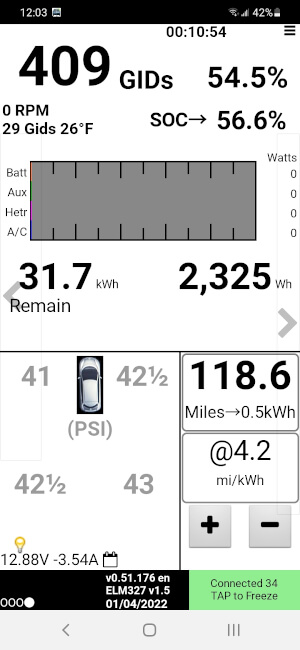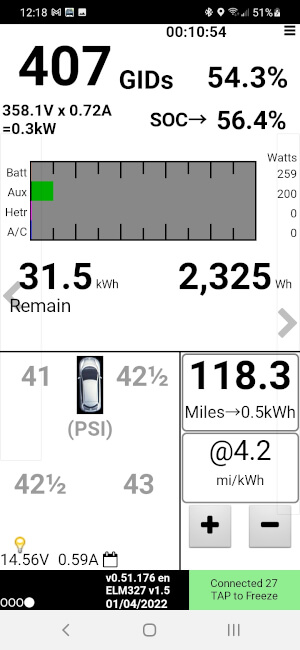knightmb said:Ok, some interesting data. Last night, I had a unique opportunity (for my area anyway) in which the temperatures fell to 19F. I knew this was coming, so I just left the hood up on my Leaf to let as much cold area get into the front where the 12V battery as possible. I also put a glass of water on top of my 12V battery to get an idea that it was really below freezing at that point. I came back out to the Leaf around midnight and the battery was covered in frost, the glass of water was a solid at that point, it was easily well below freezing. So, with everything turned off, I got a LeafSpy capture of what the Leaf was reading as battery voltage and current draw.
As you will notice from the first screen-shot, me sitting in the Leaf with the computer booted up in ACC mode is drawing about 3.54 amps or about (12.88 x 3.54) = 45.6 watts of power. So, make sure everything was off, no headlights, air, fan, unplug all power from the front console, and finally turn the Leaf on and just let it sit idle so I could watch how much power it would put back into the 12 volt battery.
At first, it started at about 10 amps, then quickly ticked down to roughly 0.6 amps and stayed there. I wanted to see if it would change or go back up but it was too cold to be sitting in the Leaf with no heat, so I just walked back into the house as my phone can reach that far with the Bluetooth with Leafspy. Watched the readings for about 15 minutes and it had not changed, it was still doing a "trickle" charge on the 12V battery. Doing the math, it was only feeding about (14.56V x 0.59A) = 8.6 watts of power into the battery. If this was a Flooded Lead Acid battery, I'm not sure if that would be enough to keep it topped off with a proper charge or not given how cold it was, but for a LFP battery getting below freezing means you can only charge at a very, very low rate. According to research papers, the allowable charge rate at –30°C (–22°F) is 0.02C at maximum. The warmer it gets, the amount ticks up a little until you finally reach the freezing point again. That means at -30C/-22F, my battery would max at (256 * 0.02) = 5 watts of safe charging current. Since LeafSpy was reading the motor at 26F, I'll use that for the battery too since it has a lot less thermal mass. I couldn't find a convenient online calculator for charge rate to temperature for the LiFePo4 12V battery. So I just used a research paper that had a -5C (23F) value instead where they tested to see what was the safe charge rate. It listed 0.05C for that temperature. It was a little lower than what I was seeing, but for this thought experiment, should be sufficient.
That means my 12V LFP battery should be able to safely charge at around (256 * 0.05) = 12.8 watts of power at that temperature.
It's interesting that the Leaf appears to be doing a low power trickle charge on purpose, well within the safety limits of my LFP. I'm curious now if that is just a normal behavior for all Leaf and charging the 12V battery or if it is actually lowering the current on purpose because it detects a below freezing outside temperature?
Either way, that may explain why my own and Stanton's LFP batteries have lasted as long as they have. Even when it's below freezing, the Leaf is not damaging our 12V batteries by trying to blast large amounts of current into it when it's below freezing. Either by accident or on purpose. :lol:


Based on your 12V battery charging current measurements, the initial 10 amp value seems excessive for a typical 51R AGM battery rated at 40 Ah, right?
Furthermore, you've not done a worst case analysis of the charging current over other conditions, e.g. temperatures. Without doing a worst case analysis,
one really doesn't know how the Leaf's 12V battery charging modes will affect an AGM battery life, being recommended as a replacement Leaf battery.
